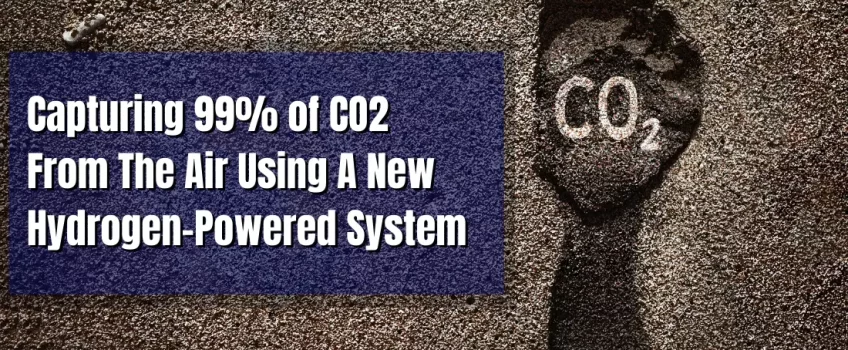
Whatever your beliefs around global warming, CO2 emissions are real and have been linked to climate change. Carbon capture is part of the solution and while it’s not a new concept, researchers from the University of Delaware have developed a new method that can remove 99% of CO2 emissions from the air. Let’s take a closer look at what carbon capture is, how the process works and what the new method entails.
What Is Carbon Capture?
As the name suggests, it refers to methods of collecting carbon from the air or from other carbon-emitting sources. In carbon capture, CO2 emissions are removed from the environment and subsequently stored as a gas. From there, it may be recycled into useful products such as fuels, fertilizers and steel or repurposed as baking soda.
How Does Carbon Capture Work?
There are two main types of carbon capture technologies: pre-combustion and post-combustion. Pre-combustion carbon capture involves removing CO2 before the fuel is burned while post-combustion is the opposite; after the fuel has burned.
With pre-combustion carbon capture technology, they use a chemical reaction to separate or absorb the CO2 from other gases. The remaining slurry is pumped into a pressurised chamber which squeezes out and collects the CO2. This technique works well for coal burning but not natural gas or biomass.
Using the post-combustion technology, exhaust gases are treated at high temperatures and passed through a solvent to separate CO2 from other gases. This is well-suited for natural gas, biomass and stationary power but not for emissions from vehicles, aircraft and ships.
A New Method For Capturing Carbon
As mentioned earlier, researchers have developed a new carbon capture method to capture 99% of CO2 emissions. To find a more effective solution than pre-and post-carbon capture technologies, their new approach uses an electrochemical system powered by hydrogen with no carbon dioxide emission. Here’s what it entails:
Capturing 99% of CO2 From The Air Using A Hydrogen System
The new carbon capture technology uses an electrochemical system powered by hydrogen. It absorbs carbon dioxide and dissolves it into a liquid solution of lithium carbonate salt and water. The subsequent chemical reaction generates methane that is separated from the other components and reused to create hydrogen gas to power everything else.
This new system is actually a result of a previous setback in another research project on hydroxide exchange membrane (HEM) fuel cells. During their efforts, the team found that HEM fuel cells were very sensitive to carbon dioxide in the air which made it difficult for the batteries to function properly.
Finding A Solution
A few years later, the researchers are using the HEM fuel cell dilemma to their advantage. They realised that “the fuel cells were capturing just about every bit of carbon dioxide that came into them, and they were really good at separating it to the other side,” said Brian Setzler, a co-author of the paper.
The research team used the “self-purging” process in HEM fuel cells to create a CO2 separator that they could place upstream from their fuel cell stacks. UD Professor and study lead Yushan Yan said, “It turns out our approach is very effective. We can capture 99% of the carbon dioxide out of the air in one pass if we have the right design and right configuration.”
For more details about the new carbon capture technology, read the team’s research paper in the journal Nature Energy.
What This New Carbon Capture Method Could Mean For The Environment
The new method of capturing CO2 has several applications, including using it as a vehicle emissions filter or for aircraft and space flights. Aside from its tremendous ability to capture CO2, the new method also has huge potential to create more sustainable fuel cells on a commercial scale. With the growing concern over CO2 emissions, this new method can help reduce the impact on the planet which will benefit everyone, now and in the future.
Carbon Capture Technology Prototype
The researchers now have a more compact system that can filter greater quantities of air. Their early prototype device is the size of a soda can and capable of filtering about 10 litres of air per minute and removing approximately 98% of CO2.
While the prototype can scrub CO2 from a vehicle’s exhaust, it has the potential to be used in a number of other applications, including aircraft, spacecraft and even submarines. This technology could have the potential to help promote maritime decarbonisation even further.
Is It Enough Or Are We Too Late?
While the new system could be hugely beneficial for improving carbon capture, some scientists have warned that carbon capture alone may not be enough to avert the impending climate crisis. In July last year, scientists from the U.S. Center for International Environmental Law suggested that carbon capture was a “dangerous distraction“.
They warned that it could be used as an excuse to slow down the transition from fossil fuels. Despite all of this and other cautionary tales, there are currently several large carbon capture projects around the world. One such example is the new carbon capture facility in Scotland that can reportedly remove up to 1 million tons of CO2 from the atmosphere per year.
Conclusion
It’s amazing how so many innovations have come about by accident or by finding a solution to a different problem. As Setzler stated, “We wanted to better understand the carbon dioxide-related mechanisms that were poisoning them. I guess we stumbled upon a solution.”
The next step for the University of Delaware is getting a patent for the new carbon capture method and also looking for industry partners to commercialise the CO2-separator technology.
We, for one, can’t wait to see what happens from here and you can also stay updated by reading our blogs and following us on social media using the hashtag #PRVtech.


 Mail:
Mail: 



